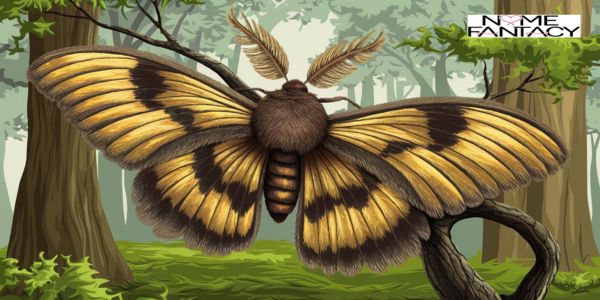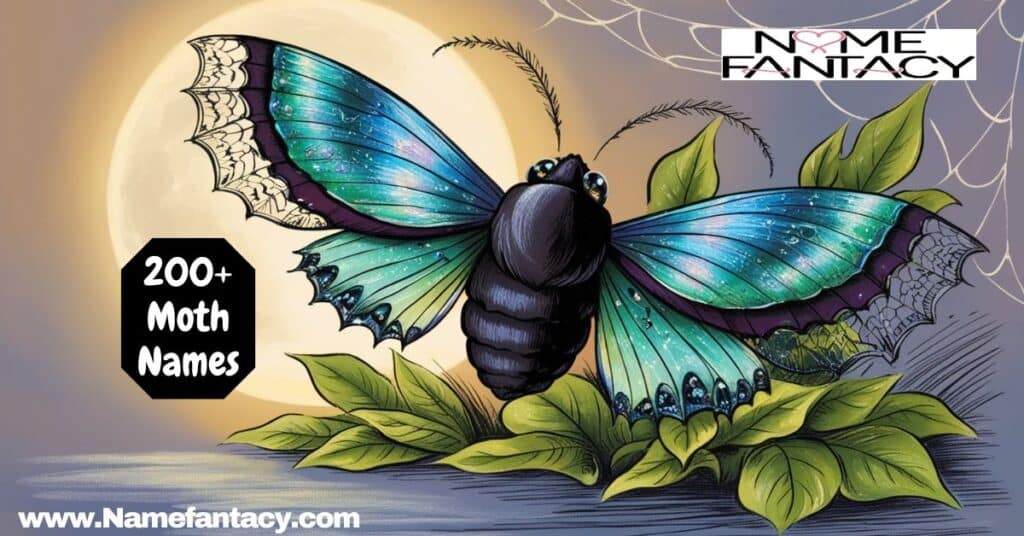In case you’re on the hunt for creative moth names, you’ve come to the right region. Whether or not you’re naming a pet, personalizing an object, or adding a fanciful touch to your life, moth-inspired names offer a satisfying combination of attraction and uniqueness.
With their swish flight and captivating beauty as nocturnal insects, moths have inspired a diverse array of names across cultures and styles. In this moth naming guide, you’ll discover over 200+ Unique Moth Names, including cute moth names, funny moth names, and even badass moth names, each with its own meaning, perfect for any occasion. You could additionally find female moth names and male moth names to suit your preferences.
Delve into this collection to locate the suitable name that resonates with you, whether you’re inquisitive about nature-inspired names, mythical moth names, or whimsical insect names. Our moth name generator can also help spark thoughts.
How to Choose a Good Name for a Moth
Choosing a good name for a moth can be a fun and creative process. Whether you’re naming a pet moth, a character, or something personal, these tips will guide you to find the perfect fit:
1. Consider the Moth’s Appearance
Look closely at the moth’s unique features. Is it delicate with pale wings or bold with striking patterns? Names like Luna for a silvery moth or Obsidian for a darker one can reflect its visual charm.
2. Think About Its Behavior
Moths are often drawn to light and are known for their fluttery nature. Consider names like Flicker or Glow to reflect their connection to nighttime or their delicate movements.
3. Draw Inspiration from Nature
Moths live in harmony with nature, so names inspired by plants or weather are a great choice. Think of Fern, Zephyr, or Meadow to highlight their natural elegance.
4. Look to Mythology and Folklore
Moths have a magical quality that pairs perfectly with mythological names. Selene (moon goddess) or Morpheus (god of dreams) bring a mystical, timeless touch to your moth’s identity.
5. Personal Preference
In the end, choose a name that feels right to you. Whether it’s a favorite word, a character from a book, or simply something that makes you smile, the right name should reflect your personal connection to the moth.
Short & Catchy Moth Names

- Luna: moonlight beauty
- Dusty: powdery wings
- Glimmer: light reflection
- Flare: drawn to flame
- Noctis: night’s essence
- Whisp: soft and fleeting
- Velvet: smooth texture
- Echo: silent movement
- Nyx: goddess of night
- Flicker: fluttering light
- Breeze: gentle motion
- Zinn: sharp elegance
- Flash: quick and bright
- Roo: small and sprightly
- Wisp: ethereal presence
- Leaf: nature’s delicate side
- Jinx: playful mystery
- Spry: lively flier
- Gust: sudden wind
- Bink: quick movement
- Floe: icy grace
- Shine: glowing softly
- Zara: radiant energy
- Lynx: elusive like a cat
- Snap: quick and precise
- Dash: fast flyer
- Twist: unpredictable path
- Jade: smooth and cool
- Zeal: full of energy
- Razz: playful and bold
Read More: Best Moose Names with
Nature-Inspired Moth Names

- Zephyr: gentle breeze
- Blossom: flower-like grace
- Fern: delicate plant
- Cinder: smoky gray hue
- Meadow: open fields
- Ember: warm glow
- Willow: soft and graceful
- Pine: enduring strength
- Mist: soft and elusive
- Rosewood: rich, fragrant tree
- Sage: wise and calming
- Holly: evergreen spirit
- Birch: light and strong
- Thorn: protective nature
- Maple: golden fall colors
- Ash: light and airy
- Ivy: clinging elegance
- Elm: sturdy and ancient
- Brook: flowing energy
- Lotus: symbol of purity
- Vine: twisting growth
- Briar: rugged charm
- Frost: winter’s touch
- Oak: symbol of strength
- Aspen: quivering leaves
- Hawthorn: protective and wild
- Lichen: quiet growth
- Clover: lucky charm
- Petal: soft and fragile
- Yarrow: healing plant
Dark & Mysterious Moth Names
Explore names that evoke a sense of mystery and intrigue, perfect for those enigmatic moths.
- Umbra: shadowy presence
- Obsidian: glossy darkness
- Raven: bird of mystery
- Midnight: deep night sky
- Vesper: evening star
- Eclipse: moonlit shadow
- Draven: dark elegance
- Onyx: polished black stone
- Ashen: ghostly gray
- Selene: moon goddess
- Tempest: stormy and wild
- Noir: timeless black
- Shade: lurking in the dark
- Blaze: fierce and bold
- Fog: enveloping mystery
- Rook: cunning like the bird
- Talon: sharp and strong
- Bane: force of destruction
- Ruin: enigmatic power
- Coal: deep black
- Wraith: ghostly figure
- Phantom: elusive and haunting
- Dire: foreboding presence
- Murk: hidden in shadows
- Void: vast emptiness
- Gloom: moody and dark
- Omen: harbinger of mystery
- Pitch: darkest black
- Sable: sleek and dark
- Raze: destroyer of barriers
Whimsical & Fantasy Moth Names

- Aurelia: Golden glow
- Elara: Celestial moon
- Faelan: Mythical creature
- Sylph: Air spirit
- Liora: Bringer of light
- Isolde: Legendary beauty
- Mithra: Light bearer
- Elowen: Nature’s guardian
- Seraphina: Angelic flame
- Zephira: Wind’s whisper
- Oberon: king of fairies
- Astra: Star-like presence
- Thalassa: Ocean spirit
- Rhiannon: Mystical queen
- Lucius: Bearer of light
- Emrys: Ancient magic
- Orla: Golden princess
- Caelan: From the heavens
- Icarus: Mythic flyer
- Eirlys: Snowdrop flower
- Nimue: Lady of the lake
- Calypso: Sea nymph
- Peregrine: Wandering traveler
- Arwen: Noble maiden
- Fenrir: Mighty wolf
- Azura: Blue sky spirit
- Baldur: Shining god
- Elric: Eternal ruler
- Zephyrine: Gentle wind spirit
- Titania: Fairy queen
Read More: Cool Zebra Names With Meaning
Cultural Moth Names
These names draw from various cultures, highlighting the rich diversity of names inspired by moths.
- Arashi: storm from Japan
- Kallisto: Greek for beautiful
- Anoki: Native actor
- Chandra: Sanskrit for moon
- Sable: French for black
- Oro: Spanish for gold
- Iskra: Slavic for spark
- Neve: Italian for snow
- Pele: Hawaiian fire goddess
- Tarik: Arabic for star
- Aya: Japanese for colorful
- Kaida: Japanese for little dragon
- Mei: Chinese for beautiful
- Dante: Italian poet
- Juno: Roman goddess
- Inez: Spanish for pure
- Tariq: Arabic morning star
- Frey: Norse god of fertility
- Zuri: Swahili for beautiful
- Amara: Greek for eternal
- Selim: Arabic for peaceful
- Yara: Brazilian water goddess
- Kiran: Indian for ray of light
- Elio: Greek for sun
- Navi: Hindu goddess
- Hoshi: Japanese for star
- Soraya: Persian for gem
- Ravi: Indian for sun
- Koa: Hawaiian for warrior
- Zara: Arabic for flower
Flower & Plant Inspired Moth Names

- Lavender: calming scent
- Lilac: light and fragrant
- Iris: vibrant beauty
- Marigold: bright bloom
- Dahlia: bold and rich
- Poppy: delicate charm
- Lotus: symbol of purity
- Thistle: rugged and wild
- Daisy: cheerful bloom
- Camellia: elegant flower
- Magnolia: grand and fragrant
- Petunia: sweet and vibrant
- Rose: classic beauty
- Tulip: colorful and bright
- Violet: soft and gentle
- Sunflower: bold and sunny
- Azalea: delicate and bright
- Zinnia: vibrant and sturdy
- Bluebell: light and sweet
- Hyacinth: rich and fragrant
- Heather: purple bloom
- Hibiscus: tropical flower
- Jasmine: sweet-scented
- Peony: lush and full
- Dandelion: playful and wild
- Clover: lucky charm
- Mint: refreshing scent
- Aster: star like bloom
- Primrose: early bloomer
Read More: Unique & Cute Ladybug Names
Mythological Moth Names

- Apollo: god of light
- Athena: goddess of wisdom
- Hermes: messenger of gods
- Selene: moon goddess
- Persephone: queen of underworld
- Orion: great hunter
- Dionysus: god of wine
- Freya: Norse goddess of love
- Poseidon: god of sea
- Helios: god of sun
- Nyx: primordial night goddess
- Hades: ruler of underworld
- Zeus: king of gods
- Artemis: goddess of moon
- Hera: queen of gods
- Loki: trickster god
- Fenrir: mighty wolf
- Achilles: legendary warrior
- Odin: all-seeing god
- Thor: god of thunder
- Hecate: goddess of magic
- Gaia: earth goddess
- Atlas: bearer of heavens
- Hera: protector of women
- Hermione: from Greek mythology
- Cerberus: guardian of underworld
- Aphrodite: goddess of love
- Pandora: first human woman
- Prometheus: bringer of fire
- Chimera: monstrous fire breather
Fun Facts About Moths
Here are some interesting and fun facts about moths that showcase their unique characteristics and behaviors.
1. Moths Are Night Owls
Moths are primarily Nocturnal, meaning they are most active at night, often attracted to moonlight and artificial lights.
2. Some Moths Wear ‘Fur’
Moths have tiny scales that give them a furry or velvety appearance. This fur helps them camouflage and maintain body temperature.
3. They Can Be Found Everywhere
Moths live on every continent except Antarctica. They’ve adapted to a variety of environments, from deserts to dense rainforests.
4. Moths Love Light
Moths are famous for being drawn to light sources, though the reason is still a mystery. Some believe they navigate using the moon and confuse artificial lights for it.
5. Moths Can Be Foodies
While some moths don’t eat at all, others have diverse diets. The Death’s head Hawk Moth, for instance, loves honey and can even sneak into beehives for a sweet treat.
Frequently Asked Questions
Here are some common questions people often have about moths, along with easy to understand answers.
1. Why are moths attracted to light?
Moths are drawn to light sources due to a phenomenon called “phototaxis.” While the exact reason is unknown, some scientists believe moths use natural light, like the moon, for navigation and get confused by artificial lights.
2. Do moths bite or sting?
Most moths are completely harmless to humans. They don’t have stingers or teeth, so they can’t bite or sting. However, some species have larvae (caterpillars) with spines that can cause irritation if touched.
3. What do moths eat?
Adult moths typically feed on nectar from flowers, while some species don’t eat at all. Moth larvae, or caterpillars, feed on a variety of plant materials like leaves, and in some cases, even fabrics.
4. How long do moths live?
The lifespan of a moth varies greatly depending on the species. Some live for just a few days, while others, like the Luna Moth, can live for up to a week. In their caterpillar stage, they may live for several weeks or months before transforming.
5. What is the difference between a moth and a butterfly?
The easiest way to tell them apart is by their antennae. Moths generally have feathery or comb-like antennae, while butterflies have thin, clubbed antennae. Moths are also mostly nocturnal, whereas butterflies are usually active during the day.
Conclusion
Moths are captivating creatures that play essential roles in our ecosystem, from pollination to serving as indicators of environmental health. With their diverse appearances, behaviors, and fascinating adaptations, they are more than just nighttime visitors. Whether you’re considering a name for a pet moth, exploring their unique qualities, or simply enjoying their beauty, there’s no denying the allure of these incredible insects. Embrace the magic of moths, and let their mysterious charm inspire your creativity and curiosity.

Zoe Robert is a experienced blogger at Name Fantacy, with a passion for exploring and sharing unique names. Her expertise lies in discovering creative, meaningful names and providing insightful details that resonate with readers.







